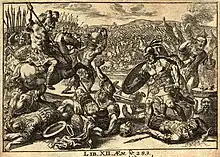Corynaeus is the name of one or more characters in Virgil's Aeneid (29–19 BCE). The first mention of Corynaeus in the poem is as a Trojan follower of Aeneas, who performs funerary rites for Misenus. Characters of the same name are then specified both as being killed by an archer, and later fighting in the final battle. This apparent contradiction is often explained by defining these as two separate characters.[1]
Narrative

In book six of the Aeneid, Corynaeus is mentioned as performing part of the burial ritual for the musician Misenus that will allow Aeneas to descend into the underworld. Corynaeus then performs the lustration ritual that follows, to purify the Trojans from contact with the dead body, by walking around them three times while sprinkling dew from an olive branch, and saying words of farewell.[2] Christian Gottlob Heyne and John Conington agree that Corynaeus is specified here merely for the sake of specifying a character.[1]
In book nine, Corynaeus is killed by the archer Asilas during Turnus' raid on the Trojan camp.[3] This is during a battle scene, with several alternating Trojan and Latin deaths seemingly designed to indicate that the state of the battle is even at this point.[4]
In book twelve, during the final battle against Turnus at Laurentum, Corynaeus is described as a bold warrior. He takes a burning firebrand from an altar, throws it into the face of the warrior Ebysus, and grabs and forces him to the ground with one knee before stabbing him in the side.[5] J. G. Cooper suggests that Corynaeus had been offering sacrifices at the altar when the battle began, calling him a Trojan priest, which recalls his role in book six.[6]
Characters
_by_Francis_Cleyn.jpg.webp)
The apparent contradiction—Corynaeus being present at the final battle despite a character of the same name being killed earlier in the story—is part of what academic Ettore Paratore describes as an "incredible confusion" of the text.[4] Macrobius pointed this out in his Saturnalia, saying Virgil "often becomes careless and confused" about his characters, giving Corynaeus as one example.[7] It is worth noting that tradition states Virgil considered the Aeneid a draft that he was in the process of revising at the time of his death,[8] and it is known to contain several similar minor contradictions.[9]
Scholars often explain the apparent contradiction by suggesting that there are two separate characters named Corynaeus.[10] Conington says that both are most likely Trojan companions of Aeneas, and that the first mention in book six may refer to either of the other two.[1] Philologist Hugo Merguet and the Enciclopedia Virgilian agree that all mentions of Corynaeus refer to Trojans, though they also refer to his opponent Asilas as Trojan as well.[4] Frederick Ahl, Henry Simmons Frieze, and John Bell connect the Corynaeus of books six and twelve, calling the mention in book nine a separate character.[11][12][13] Academics Catherine Saunders and Jacob Hammer instead group the first two mentions together, describing the character as a Trojan priest, while calling the character of book twelve a Latin (Saunders) or a Rutulian (Hammer).[14][15] Gavin Douglas called Corynaeus "a stowt Troiane" in book twelve, while the character in book nine is on the opposing side to Asilas, who he calls a Phrygian.[16] Francis Gouldman defined the Corynaeus of book nine as a Rutulian, and called him a "skilful darter",[17] following Charles Estienne's interpretation that the archer mentioned in book nine referred to Corynaeus, not Asilas.[18] Benjamin Hall Kennedy has both Asilas and Ebysus as Trojans, while listing Corynaeus with the soldiers of Turnus, and only assigning the Corynaeus of book six to the Trojans.[19] Charles Anthon suggests that Ebysus' beard was in the Etrurian fashion, making him one of Mezentius' Etruscan warriors, and as a result says the Corynaeus of book twelve must be a Trojan.[20] Ahl notes that many characters on both sides of the conflict have the same names, saying that this enhances the sense that it is describing a civil war.[11]
Name

There are various spellings of the name in the surviving manuscripts of the Aeneid. Christian Gottlob Heyne remarked that the correct Greek form was Κορυναῖος (Korynaios) from Κορύνη (Korynē):[1] 'club' (often iron shod) or 'mace'.[21] Saunders agreed with this etymology for the name of Corynaeus of book twelve, as suggested by his throwing of a club (the burning firebrand) at Ebysus,[14] but put forward an alternative etymology for the Corynaeus of books six and nine, who she described as one of several Trojan characters who may have their names derived from places: in this instance either the Corynaeum, a peak of Mount Mimas, or the city of Koryne below it.[14]
Early English translations of the Aeneid also vary in their spelling of Corynaeus' name. Gavin Douglas' Eneados (1513) spelled the name "Choryneus" in books six and nine, and "Chorineus" in book twelve.[16] Thomas Twyne's 1584 completion of Thomas Phaer's translation of the Aeneid changed Corynaeus' name to "Sir Chorinee", which academic Steven Lally thought transformed it from an epic name into one which has "a peculiarly English sound, almost a low or clown-like familiarity".[22] John Dryden's 1697 loose translation calls him "Old Chorineus" in book six, and "Priest Chorinæus" in book twelve, while omitting the name of Asilas' victim in book nine.[23]
Legacy
_p110.jpg.webp)
Ovid's Metamorphoses (8 CE) describes how Athis is killed by Perseus with a log that had been smoldering in the middle of the altar. Alison Keith suggests that this was modelled on Corynaeus' killing of Ebysus in the Aeneid.[24]
Oxyrhynchus Papyrus 3876 recounts that "Aeolus' cousin tends the corpse, and sets about the pyre". Trying to establish who this refers to, M. W. Haslam suggests that the body could be Misenus (who is referred to as an Aeolian by Virgil) and Aeolus' cousin could be Corynaeus, as the grandfather of Aeolus from the Aeneid was Mimas, who shares a name with Mount Mimas, close to the Corynaeum promontory that may have given Corynaeus his name. However Hugh Lloyd-Jones dismisses this suggestion, remarking that Haslam is "catching at a straw".[25]
The name Corynaeus probably served as the inspiration for Geoffrey of Monmouth's character Corineus, a descendant of the Trojans, and the eponymous founder of Cornwall in the Historia Regum Britanniae (c. 1136).[3] This Corineus is mentioned in Gottfried von Strassburg's Tristan (c. 1210) when referring to a cave from "before Corynaeus' day" shared by the lovers Tristan and Iseult; John Anson suggests that von Strassburg's use of Virgil's spelling Corynaeus here is deliberately deployed with an intention to recall the Aeneid's Dido and Aeneas.[26]
William Shakespeare's The Comedy of Errors (c. 1589–1595) contains a line describing a doctor "Whose beard they have singed off with brands of fire" (Act 5, Scene 1). Charles Knight suggested that this was based on Corynaeus' setting fire to Ebysus' beard in the Aeneid. Charlotte Porter and Helen A. Clarke support this theory, and say that Shakespeare may have taken it from Twyne's translation.[27]
The threefold circumambulation and sprinkling of dew in Corynaeus' lustration ritual in book six may have inspired similar lines in John Fletcher's The Faithful Shepherdess (1609), and John Milton's Comus (1634).[28]
References
- 1 2 3 4 Conington, John (1876). Commentary on Vergil's Aeneid. Vol. 1. London: Whittaker and Co. 6.228.
- ↑ Conington, John (1876). Commentary on Vergil's Aeneid. Vol. 1. London: Whittaker and Co. 6.229.
- 1 2 Bartrum, Peter C. (2009) [1993]. "Corineus" (PDF). In MPS (ed.). A Welsh Classical Dictionary. Vol. 4. National Library of Wales. p. 166.
- 1 2 3 Willcock, M. M. (2002). "Virgilian Battle Scenes". The Classical Review. Cambridge University Press. 52 (1): 61–63. doi:10.1093/cr/52.1.61. ISSN 0009-840X. JSTOR 3662483. Retrieved 8 May 2022.
- ↑ Curley, Michael J. (1994). "Geoffrey of Monmouth". New York: Twayne Publishers. pp. 17–18.
- ↑ Cooper, J. G., ed. (1846). Opera; or, The Works of Virgil. New York: Pratt, Woodford & Company. p. 580.
- ↑ Macrobius (2011). Saturnalia. Loeb Classical Library. Translated by Kaster, Robert A. Cambridge, MA: Harvard University Press. book 5, chapter 15, section 10. OCLC 902697002.
- ↑ Sellar, William Young; Glover, Terrot Reaveley; Bryant, Margaret (1911). . In Chisholm, Hugh (ed.). Encyclopædia Britannica. Vol. 28 (11th ed.). Cambridge University Press. p. 112.
- ↑ Knox, Bernard (2006). "Introduction". The Aeneid. Penguin Classics (Deluxe ed.). Penguin. p. 29. ISBN 978-1-101-20154-1.
- ↑ Lewis, Charlton Thomas; Short, Charles, eds. (1879). "Cŏrynaeus". Harpers' Latin Dictionary. New York: Harper and Brothers.
- 1 2 Ahl, Frederick (2007). Aeneid. Oxford world's classics. Ebsco Publishing. p. 437. ISBN 978-0-19-151778-5. Retrieved 9 May 2022.
- ↑ Frieze, H.S. (1882). A Vergilian Dictionary. D. Appleton. p. 48. Retrieved 9 May 2022.
- ↑ Bell, John, ed. (1790). Bell's New Pantheon. Vol. 1. London: John Bell. p. 178.
- 1 2 3 Saunders, Catharine (1940). "Sources of the Names of Trojans and Latins in Vergil's Aeneid". Transactions and Proceedings of the American Philological Association. [Johns Hopkins University Press, American Philological Association]. 71: 546. doi:10.2307/283143. ISSN 0065-9711. JSTOR 283143. Retrieved 8 May 2022.
- ↑ Hammer, Jacob (1944). "Remarks on the Sources and Textual History of Geoffrey of Monmouth's Historia Regum Britanniae". Bulletin of the Polish Institute of Arts and Sciences in America. Polish Institute of Arts & Sciences of America. 2 (2): 508. ISSN 0376-2327. JSTOR 24725056. Retrieved 9 May 2022.
- 1 2 Eneados. Translated by Douglas, Gavin. Edinburgh: Bannatyne Club. 1839 [1513].
- ↑ Gouldman, Francis (1664). Dictionarium Etymologicum, Philologicum, Phraseologicumque. London: Joannes Field. CHR: Chorinæus.
- ↑ Estienne, Charles (1541). Dictionarium Propiorum Nominum Virorum (in Latin). Robertus Stephanus. p. 150.
- ↑ P. Vergili Maronis (1879). Kennedy, Benjamin Hall (ed.). Bucolica, Georgica, Aeneis (2 ed.). London: Longmans, Green & Co. pp. 703, 704, 713–714. hdl:2027/hvd.32044018816116.
- ↑ Anthon, Charles, ed. (1849). The Æneïd of Virgil. New York: Harper and Brothers. p. 866. hdl:2027/nyp.33433082190111.
- ↑ "Greek Word Study Tool". Perseus Digital Library. Retrieved 7 May 2022.
- ↑ Lally, Steven, ed. (1987). The Aeneid of Thomas Phaer and Thomas Twyne. Renaissance Imagination. Garland. p. xl. ISBN 0824084101.
- ↑ Virgil (1697). The Works of Virgil: Containing His Pastorals, Georgics, and Æneis. Translated by Dryden, John. London: Jacob Tonson. pp. 372, 487, 591.
- ↑ Keith, Alison M. (2002). "Ovid on Vergilian War Narrative". Vergilius. The Vergilian Society. 48: 114–115. ISSN 0506-7294. JSTOR 41587270. Retrieved 9 May 2022.
- ↑ Lloyd-Jones, Hugh (1991). "The Cousin of Aiolos Hippotades (Stesichorus (?), P.Oxy. 3876, Fr. 62)". Zeitschrift für Papyrologie und Epigraphik. Bonn: Rudolf Habelt. 87: 297–300. ISSN 0084-5388. JSTOR 20187522. Retrieved 9 May 2022.
- ↑ Anson, John S. (1970). "The Hunt of Love: Gottfried Von Strassburg's Tristan as Tragedy". Speculum. Medieval Academy of America, Cambridge University Press, University of Chicago Press. 45 (4): 600. doi:10.2307/2855671. ISSN 0038-7134. JSTOR 2855671. S2CID 171024685. Retrieved 9 May 2022.
- ↑ Shakespeare, William (1903). Porter, Charlotte; Clarke, Helen A. (eds.). The Comedie of Errors. New York: Thomas Y. Crowell & Co. p. 135. hdl:2027/hvd.hwnqpp.
- ↑ Shakespeare, William (1844). Travers, Charles (ed.). Shakspeare's Tragedy of Macbeth. Boulogne: Leroy-Mabille. p. 142.
External links
- Perseus Project A.6.228 – Aeneid, book 6, card 228
- Perseus Project A.9.571 – Aeneid, book 9, card 571
- Perseus Project A.12.298 – Aeneid, book 12, card 298
